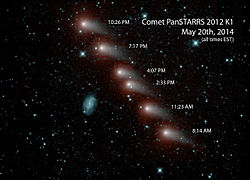 NEOWISE series of infrared images of C/2012 K1 on 20 May 2014 NEOWISE series of infrared images of C/2012 K1 on 20 May 2014 | |
| Discovery | |
|---|---|
| Discovered by | Pan-STARRS 1.8-m Ritchey–Chrétien (F51) |
| Discovery date | 17 May 2012 |
| Orbital characteristics | |
| Epoch | 11 August 2014 |
| Orbit type | Oort cloud |
| Aphelion | ~52000 AU (inbound) ~14000 AU (outbound) |
| Perihelion | 1.0545 AU (q) |
| Eccentricity | 1.00021 |
| Orbital period | several million years inbound (Barycentric solution for epoch 1950) ~600000 yr outbound (Barycentric solution for epoch 2050) |
| Inclination | 142.43° |
| Last perihelion | 27 August 2014 |
| Jupiter MOID | 1.5 AU |
C/2012 K1 (PanSTARRS) is a retrograde Oort cloud comet discovered at magnitude 19.7, 8.7 AU from the Sun on 17 May 2012 using the Pan-STARRS telescope located near the summit of Haleakalā, on the island of Maui in Hawaii (U.S.).
The comet started 2014 as a Northern Hemisphere object. By late April 2014 it had brightened to roughly apparent magnitude ~8.8 making it a small telescope/binoculars target for experienced observers. In June and July 2014 the comet was near the Sickle of Leo. As of 3 July 2014 the comet had brightened to magnitude 7.9.
From 12 July 2014 until 6 September 2014 it had an elongation less than 30 degrees from the Sun. The comet came to perihelion (closest approach to the Sun) on 27 August 2014 at a distance of 1.05 AU (157,000,000 km; 98,000,000 mi) from the Sun. It crosses the celestial equator on 15 September 2014 becoming a Southern Hemisphere object.
The comet peaked around magnitude 6.9 in mid-October 2014 when it had an elongation of around 75 degrees from the Sun. It is visible in binoculars and small telescopes.
References
- ^ "MPEC 2012-K36 : COMET C/2012 K1 (PANSTARRS)". IAU Minor Planet Center. 21 May 2012. Retrieved 5 May 2013. (CK12K010)
- ^ "MPEC 2014-K54: Observations and Orbits of Comets". IAU Minor Planet Center. 26 May 2014. Retrieved 15 June 2014.
- ^ Horizons output. "Barycentric Osculating Orbital Elements for Comet C/2012 K1 (PANSTARRS)". Solution using the Solar System Barycenter. Ephemeris Type:Elements and Center:@0 (To be outside planetary region, inbound epoch 1950 and outbound epoch 2050)
- ^ "Elements and Ephemeris for C/2012 K1 (PANSTARRS)". IAU Minor Planet Center. Archived from the original on 28 August 2013. Retrieved 5 May 2013.
- Bob King (11 June 2014). "Comet PanSTARRS Keeps Getting Better". Sky & Telescope.
- Seiichi Yoshida (20 July 2014). "Weekly Information about Bright Comets (2014 July 5: North)". Seiichi Yoshida's Comet Catalog. Retrieved 23 July 2014.
- Yoshida, Seiichi (20 October 2014). "Weekly Information about Bright Comets (2014 Oct. 18: South)". aerith.net. Retrieved 21 October 2014.
- Seiichi Yoshida (29 April 2013). "C/2012 K1 ( PanSTARRS )". Seiichi Yoshida's Comet Catalog. Retrieved 5 May 2013.
External links
- Get Set For Comet K1 PanSTARRS: A Guide to its Spring Appearance (Universe Today 17 March 2014)
- Comet Pan-STARRS Marches Across the Sky (3 July 2014)
- C/2012 K1 in the constellation Puppis. Captured 10-23-2014
| 2013 in space | ||||||
|---|---|---|---|---|---|---|
| Space probe launches |
|    | ||||
| Impact events | ||||||
| Selected NEOs | ||||||
| Exoplanets |
| |||||
| Discoveries |
| |||||
| Novae | ||||||
| Comets | ||||||
| Space exploration |
| |||||
| 2014 in space | ||
|---|---|---|
| Space probe launches |
|    |
| Impact events | ||
| Selected NEOs | ||
| Exoplanets | ||
| Discoveries |
| |
| Novae | ||
| Comets | ||
| Space exploration |
| |

